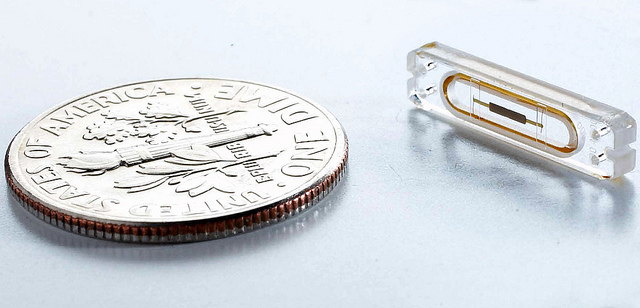
Sensor technology will soon reach into all facets of life from airports to water lines

Photo of a wireless sensor by Intel Free Press is licensed under CC BY 2.0
For Texans who have not focused on sensor technology … it’s time! There is no time to waste. This is a huge marketplace – one that is growing at breakneck speed. The market for sensor technology is projected to exceed $20 billion by 2020 and the ramifications are huge.
This new marketplace will, without doubt, influence transportation, water resources, infrastructure monitoring, health care and environmental sustainability. In fact, all kinds of monitoring are already occurring. It is happening all around us, but few people outside of government have realized it.
Sensors come in literally thousands of sizes, shapes and types. And, the technology is being used to monitor water supplies, vehicular emissions, combustion of fossil fuels, agricultural run-off, the disposal of industrial and mine waste, ocean spills, weather patterns, climate change and seismic events. Sensors also are being placed in clothing and they exist in smart phones and health care devices that individuals wear so that critical data can be collected. Sensors are being embedded in roads, bridges and on airport runways. Other sensor applications continually search for intentionally placed chemicals and/or biohazards that could be linked to terroristic activity.
The growth of this marketplace is fueled and impacted positively or negatively by many things, but governments worldwide have ramped up initiatives and funding of sensor-related technologies. Environmental sensing and monitoring is becoming common. Public officials in every jurisdiction work to prevent and control pollution of air, soil and water and they monitor progress with sensors. Pollution control and weather monitoring alone currently total about $250 billion in economic activity in the U.S.
Where once large, stationary, expensive sensors were required, monitoring today can be done with much smaller and less costly equipment. That has allowed sensor monitoring services to become feasible for cities, counties and states. It also has spurred the growth of small businesses that offer sensors, services and data analysis.
The potential for sensor initiatives is truly mind-boggling. UCLA’s Center for Embedded Networked Sensing (CENS) is a major research enterprise that focuses on developing and applying wireless sensing systems to critical scientific and societal pursuits. In the same way the Internet transformed our ability to communicate, the decreasing size and cost of computing components is setting the stage for a major shift in detection, processing and communication technology.
Companies that will profit from this multi-billion-dollar industry are those that proactively approach government, armed with innovative, cost-effective sensor solutions and a viable means to implement them. It’s a marketplace that definitely should not be overlooked.
